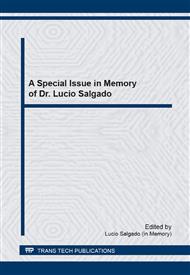p.143
p.149
p.155
p.161
p.167
p.172
p.178
p.184
p.190
Effect of Different Dopants in Films TEOS/MPTS Used to Protect the Carbon Steel
Abstract:
Schiff bases m-toluene N-Salicylideneaniline (m-TOL), (B) m-nitro-N- Salicylideneaniline (m-NTR) and (C) m-methoxy-N-salicylideneaniline (m-MTX) and cerium ions were studied added to 3.5 wt.% NaCl solution and added to the hybrid film based tetraethoxysilane (TEOS) e 3-methacryloxypropyltrimethoxysilane (MPTS). The polarization measurements showed lower current densities for the steel in NaCl with m-MTX, indicating that the m-MTX may be acting as an inhibitor. The hybrid films were doped with the m-MTX, Ce (III) or Ce (IV). Electrochemical measurements of open circuit potential (EOC), polarization curves and electrochemical impedance spectroscopy (EIS), were used to evaluate the corrosion behavior of the hybrid films. According Electrochemical Impedance measurements, all hybrid films, provided protection to the carbon steel. The films doped with Ce (IV), provided greater protection than the other, which indicates that this is the most suitable dopant for use in films.
Info:
Periodical:
Pages:
167-171
Citation:
Online since:
September 2014
Authors:
Keywords:
Price:
Сopyright:
© 2015 Trans Tech Publications Ltd. All Rights Reserved
Share:
Citation:


